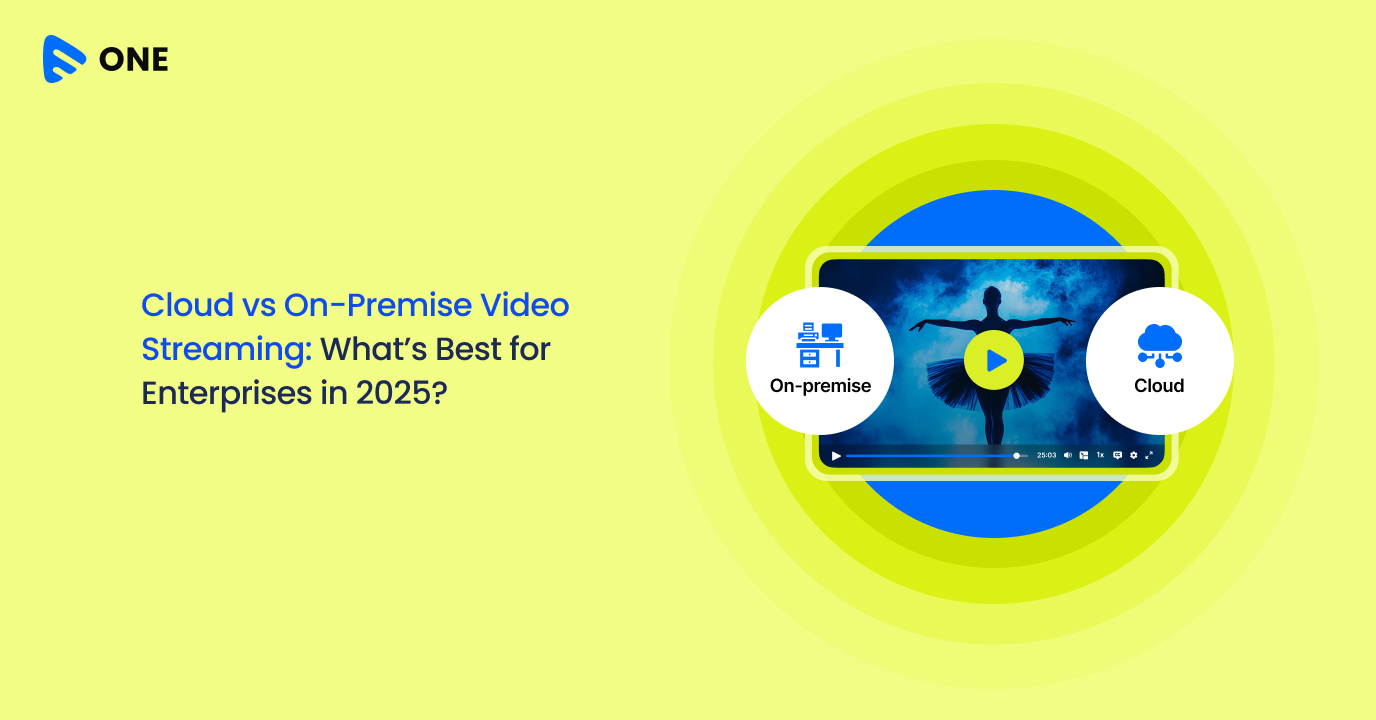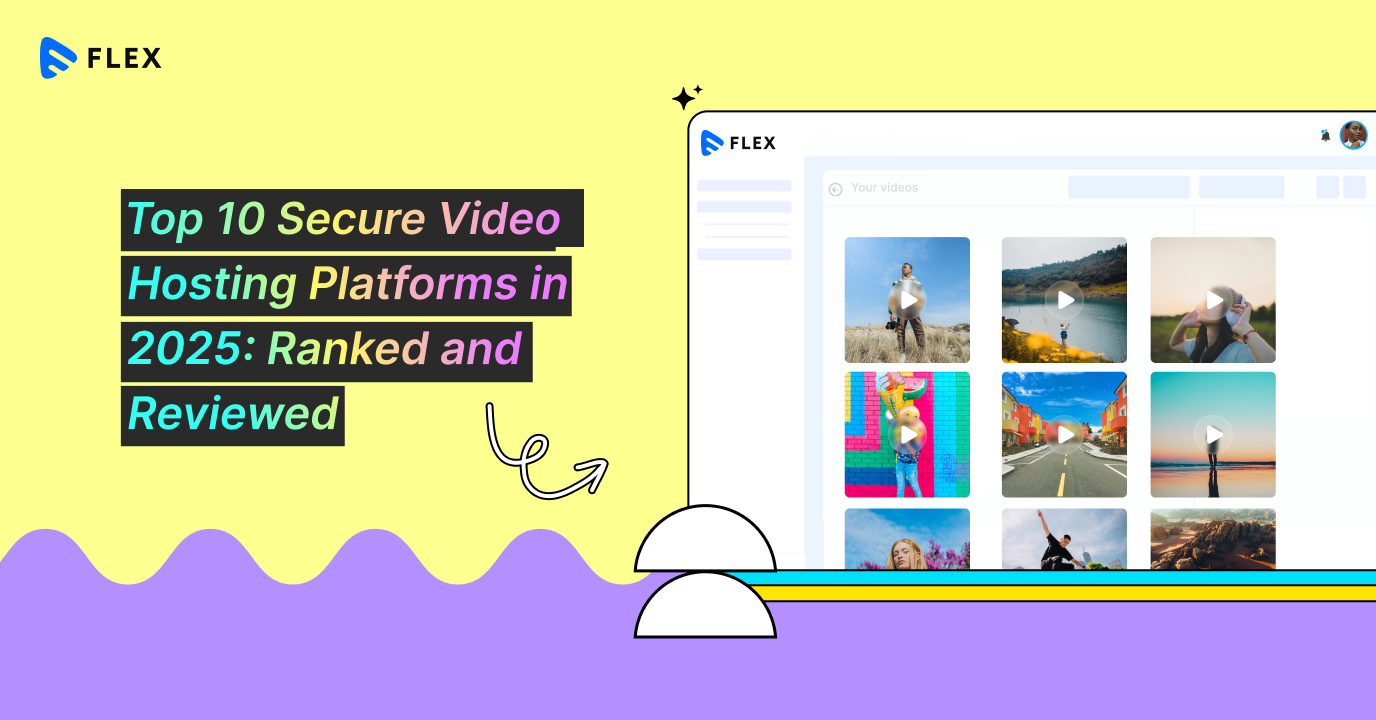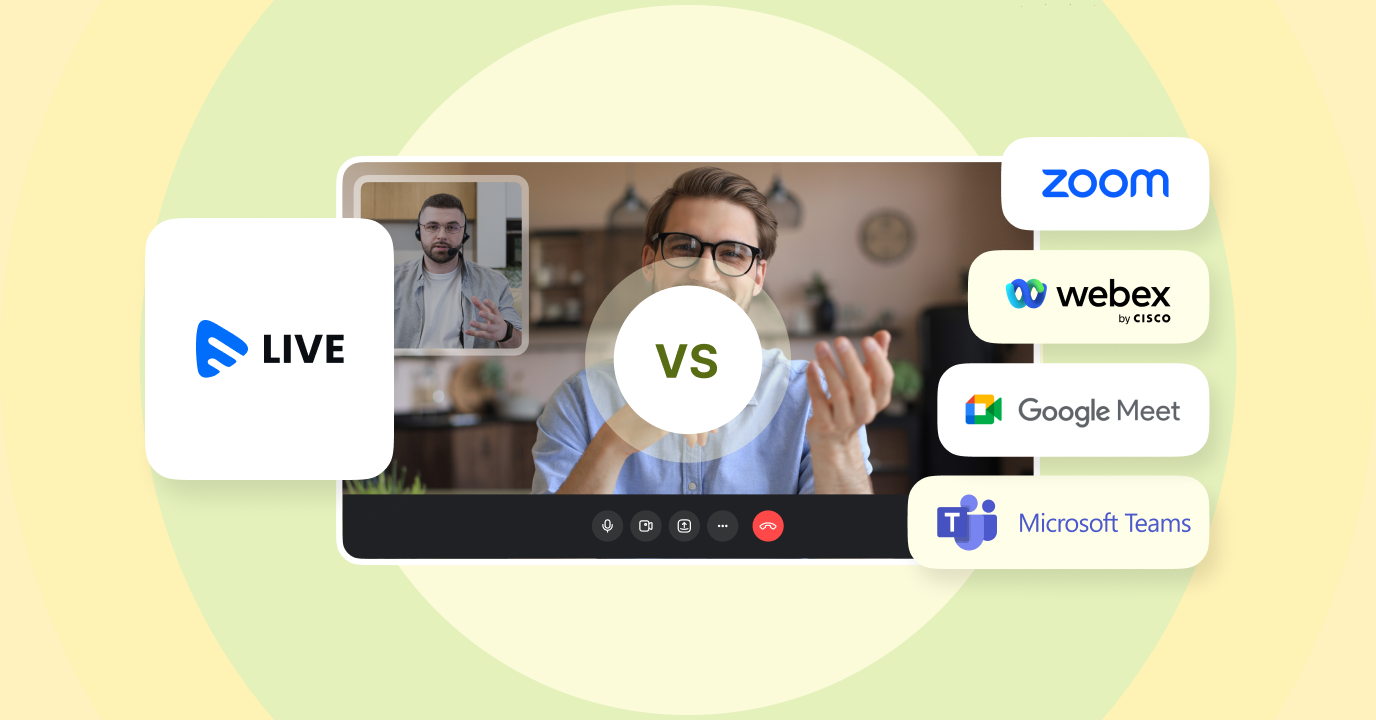As enterprises increasingly rely on video for multiple purposes like communications, marketing, and training, choosing between cloud and on-premise video streaming setups is critical for their growth and sustainability.
In this blog, we will delve into the nuances of cloud-based, on-premise, and private cloud video streaming, helping you weigh the pros and cons to determine the optimal setup for your enterprise’s unique streaming needs.
What is Cloud-Hosted Video Streaming?
Cloud-based video streaming is one of the most preferred and picked solutions for storing, processing, and distributing videos online. The cloud-based streaming setup utilizes remote servers hosted on third-party cloud providers, such as AWS, Azure, or Google Cloud.
Such cloud-based streaming infrastructure does not require any physical server setup or maintenance – you simply need to subscribe to the cloud video hosting services and start streaming your videos. This model operates on a “pay-as-you-go” basis, meaning you only pay for the resources you consume – hence, no worries about high storage and bandwidth costs.
Benefits of Cloud-Hosted Video Streaming:
- Scalability: This is arguably the biggest advantage. Cloud video streaming platforms offer unparalleled elasticity, allowing enterprises to instantly scale their streaming capabilities up or down based on demand. Whether you experience a sudden surge in viewers for a live event or need to accommodate rapid growth, the cloud streaming server can handle it without significant upfront investment in hardware.
- Cost-Effectiveness: Reduced upfront capital expenditure is a major draw. Enterprises avoid the large initial investments in servers, storage, and networking equipment. Operational costs become more predictable, with expenses shifting from CapEx to OpEx.
- Global Reach & Performance: Cloud service providers have vast global networks of data centers and Content Delivery Networks (CDNs). This ensures that your video content is delivered from the nearest server to your viewers, significantly reducing latency, buffering, and providing a smoother, higher-quality viewing experience worldwide.
- Reduced Maintenance Burden: The cloud provider is responsible for maintaining, updating, and patching the server infrastructure. This frees up internal IT teams to focus on core business initiatives rather than hardware management.
- Disaster Recovery & Redundancy: Cloud video hosting platforms typically offer robust disaster recovery capabilities and redundant storage across multiple locations, ensuring high availability and protecting your valuable video assets from unforeseen events like hacking/downtime.
Limitations of Cloud-Hosted Video Streaming:
- Dependency on Internet Connectivity: A stable and high-bandwidth internet connection is essential for accessing and managing cloud-based video streaming services. Any disruption can impact streaming performance.
- Potential for Vendor Lock-in: Migrating from one cloud video hosting provider to another can be complex and costly, potentially leading to vendor lock-in if not planned carefully.
- Security & Compliance Concerns: While cloud video streaming providers offer robust security, the responsibility for data security is shared. Enterprises must ensure their configurations and practices align with their specific compliance requirements (e.g., GDPR, HIPAA), especially for sensitive content.
- Cost Management Complexity: While cost-effective, managing cloud video streaming setup can become complex if not actively monitored, as usage-based pricing can fluctuate.
- Less Customization at the Infrastructure Level: While flexible, cloud video streaming environments offer less granular control over the underlying hardware and network configurations compared to on-premise setups.
Host videos on a secure cloud video streaming platform.
Get started with Muvi One today.
What’s On-Premises Video Streaming Model?
On-premises video streaming involves storing and managing video content on the physical servers and infrastructure within an enterprise’s own data center or facility. On-premises video streaming setup requires no cloud infrastructure as the enterprise solely handles everything – procurement, installation, maintenance, and security of the entire streaming ecosystem.
This kind of streaming model gives complete control over data storage, server configurations, and security, thus making it a preferred choice for enterprises having strict compliance requirements like healthcare, government, and banking institutions.
Benefits of On-Premises Video Streaming:
- Full Control & Customization: Enterprises have complete control over their servers, content delivery networks, and platform configurations. This allows for highly tailored video streaming solutions, like you can set up your own CDNs, Storage, and also choose your on-premise encoder applications for greater control.
- Enhanced Security: For highly sensitive or confidential video content, on-premise deployments can offer a greater sense of security as data never leaves the company’s direct control. This can be crucial for industries with strict regulatory compliance.
- Data Sovereignty: Maintaining data within your own physical boundaries can be vital for adhering to specific data residency laws and regulations in certain geographies or industries.
- Predictable Costs (After Initial Investment): While initial costs are high, once the infrastructure is in place, ongoing operational costs for server setup and streaming infrastructure can be more predictable, avoiding the variable costs associated with cloud usage.
- No Reliance on External Internet (for internal streams): For internal corporate communications or training videos, an on-premise video streaming setup can offer independence from external internet disruptions, ensuring continuous service within the corporate network.
Get started with flexible on-premise video hosting & streaming services powered by Muvi One. Talk to our experts.
Limitations of On-Premises Video Streaming:
- High Upfront Investment: Significant capital expenditure is required for purchasing servers, storage, networking equipment, and software licenses.
- Limited Scalability: Scaling on-premise infrastructure to handle sudden spikes in demand is a time-consuming and expensive process, requiring additional hardware procurement and deployment.
- Higher Maintenance & Operational Overhead: Enterprises are responsible for all aspects of maintenance, including hardware upgrades, software patching, security monitoring, and staffing a dedicated IT team to manage the infrastructure.
- Slower Deployment: Setting up an on-premise streaming solution can take significantly longer than deploying a cloud-based service.
- Geographic Limitations: Delivering high-quality video globally from a single on-premise location without a robust CDN can be challenging and expensive, leading to latency issues for remote viewers.
- Risk of Hardware Failure: The enterprise bears the full risk and cost associated with hardware failures, requiring robust backup and disaster recovery plans.
So, this is a brief on what cloud vs on-premises video streaming looks like. Apart from these two setups, enterprises also prefer a private cloud setup or a hybrid solution for video streaming. Let’s have a look at that.
What’s Private Cloud Video Streaming Setup?
A private cloud setup for video streaming combines elements of both cloud infrastructure and on-premise models. It refers to a cloud computing environment dedicated exclusively to a single enterprise. This can be hosted on-premises within the company’s data center or managed by a third-party video hosting provider on dedicated infrastructure. The key is that the cloud setup resources are private to the enterprise and not shared with other organizations.
Benefits:
- Enhanced Security & Control: Similar to on-premise, private clouds offer a high degree of control over data security and compliance, as the infrastructure is dedicated.
- Improved Performance: With dedicated resources, enterprises can often achieve optimized performance for their specific video streaming workloads, free from the “noisy neighbor” effect sometimes experienced in public clouds.
- Customization: Private clouds offer greater customization options than public cloud setups, allowing enterprises to tailor the video streaming environment to their exact requirements.
- Scalability (within dedicated resources): While not as infinitely scalable as public clouds, private clouds offer more flexibility and elasticity than traditional on-premise setups, allowing resources to be allocated and reallocated more efficiently within the dedicated infrastructure.
What is the Difference Between Cloud and On-Premise Video Streaming?
To understand Cloud vs On-Premise Video Streaming: What’s Best for Enterprises in 2025, it’s important to analyse the core differences that lie in ownership, responsibility, cost structure, and scalability:
Feature | Cloud-Based Video Streaming | On-Premise Video Streaming |
Infrastructure | Owned and managed by a third-party cloud provider. | Owned and managed by the enterprise. |
Responsibility | Cloud provider handles infrastructure, enterprise manages application and data. | Enterprise is responsible for everything (server, infrastructure, maintenance, security). |
Cost Model | Pay-as-you-go, OpEx. Lower upfront, usage-based variables | High upfront CapEx, more predictable ongoing costs. |
Scalability | Highly elastic, scales instantly. | Limited, scaling requires significant effort and investment. |
Deployment Time | Fast, often minutes to hours. | Slow, can take weeks or months |
Maintenance | Handled by a cloud provider. | Handled by the internal IT team. |
Global Reach | Excellent, leverages global CDNs. | Challenging and costly without significant external investment. |
What’s the Best: Choosing Between Cloud and On-Premises Video Streaming
Truly, there is no winner for cloud vs on-prem video streaming. Each streaming setup has its own advantages and needs. The ideal video streaming infrastructure is the one that aligns with your enterprise’s unique streaming needs and compliance requirements.
One key point to understand is that the core components of a streaming platform—video processing and delivery, backend operations, and support services—can be effectively deployed either in the cloud or on-premises. The right choice depends heavily on your specific business needs, whether you’re aiming to optimize costs and expand your reach with cloud solutions or prefer to maintain tighter control with an on-premise setup.
Muvi One empowers you to deploy your video streaming service in the environment that best suits your requirements. The end-to-end customizable streaming platform can be deployed in any environment – cloud, on-premise, or private cloud, depending on the business strategy and streaming requirements.
Whether you’re looking for the flexibility and scalability of cloud-based streaming solutions or the control and security of the on-premise servers, Muvi One supports every kind of streaming setup.
Want to take a demo of Muvi One? Click here to get started.

Recommended Reads:
Cloud Video Encoding vs On-Premise: Pros, Cons, and Beyond
Addressing Cloud Security: Why is it Important?
Why Should Businesses Opt for Cloud Video Hosting?
What is Hybrid Cloud? Everything You Need to Know
Multi-cloud Vs Hybrid Cloud Solution: All You Need to Know














Add your comment